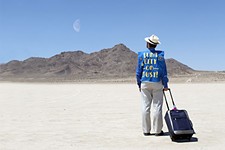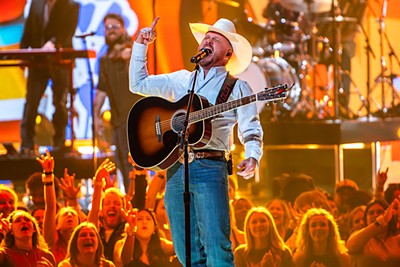Maverick Outsider
Austin Film Society's Expanding Cinema Series: Willie Varela
By Athina Rachel Tsangari, Fri., Oct. 29, 1999

Willie Varela is a renegade avant-garde filmmaker from El Paso, a Chicano visionary artist, a lone West Texas shooter, an illuminating teacher, and an incessant image-maker. Varela has been making personal cinema for nearly 30 years. Since 1971, Varela has produced more than 70 films in Super-8 and has completed more than 15 videotapes in Hi-8. He has exhibited his work at independent film showcases throughout the United States at the MoMa, the Whitney Biennials, the San Francisco Cinematheque, the Collective for Living Cinema, the Guggenheim and elsewhere. In 1994, the Whitney Museum of Art presented his mid-career retrospective. He currently teaches film at the University of Texas at El Paso.
This month's featured artist in the Austin Film Society's Expanding Cinema series on Wednesday, November 3, Varela has been described by none other than the "dean" of American experimental filmmakers, Stan Brakhage, as follows: "Willie, you're a master in the Confucian sense -- i.e. you've gone thru to the rhythms of your heart -- and steadied the wobbling-pivot there -- It is so encouraging to me, in tough and dangerously bitter Times like these, to see such naturalness flourishing in film."
Austin Chronicle: How did it all start for you as a filmmaker?
Willie Varela: I started shooting Super-8 film in 1971. This was back in a time when, according to many historical texts and people like Jim Hoberman, supposedly the first and only significant wave of American avant-garde filmmaking had already almost come to pass. Hoberman has gone on record as saying that, after [Stan] Brakhage, [Kenneth] Anger, [Bruce] Conner, etc. did their best work, it didn't occur to anybody that there would actually be other subsequent waves of experimental filmmakers. But since I was living in El Paso, in a very isolated place -- these kinds of films had never come here -- when I got into filmmaking, fortunately for me, I wasn't aware that everything was supposed to be over.
AC: Were you aware of the avant-garde "scene" at all?
WV: I was, but only in a very tentative and peripheral way. I'd become seriously interested in film when I was 17 years old. The Vietnam War was raging, and I was very aware that I didn't want to go into the Army. So I experienced a kind of "lost period" between 18 and 22 where I was in and out of college, in and out of jobs, and I just couldn't seem to find myself. Then I bought a book, An Introduction to the American Underground Film by Sheldon Renan, the first serious treatment of what was known then as the New American Cinema. I read it from cover to cover several times, the biographies of people like Bruce Conner, Kenneth Anger, Jonas Mekas, and of course, Stan Brakhage, who it mentioned was deeply involved in a series of 8mm films called "Songs." I thought: Wow, this is amazing! This is a guy who's not in Hollywood, doesn't seem to be interested in Hollywood, certainly isn't making big-budget 35mm motion pictures -- but rather small intimate films about his life, his environment, his obsessions, and yet they were being seen and taken very seriously. -- The third element that came into place to inspire me was an interview in Rolling Stone in the early Seventies with John Lennon, where he mentioned that part of his "rehabilitation" from being a rock star was that he started taking photographs and making 8mm films.
AC: What transformations has your work undergone throughout these three decades?
WV: The period between 1974 to 1984 was a very fertile period. It yielded about 35 films, and it primarily explored aspects of montage, rhythm, light, and color, as inspired by people like Brakhage and Eisenstein. Most of my subject matter came from my own personal life, and occasionally it would extend out to the world, such as a series of portraits of a cemetery here in El Paso. These films expressed my own sense of being an outsider, a Chicano, and especially being a lapsed Catholic, feeling affinity for Buñuel, Tarkovsky and Scorsese's work.
AC: Is your identity as a Chicano crucial to your filmmaking practice?
WV: It became crucial once I started to make a break with this type of work in the mid-Eighties. I reached a point when the world wasn't as beautiful as it had once been. After my five-year period in San Francisco and my exposure to Bay Area activism and the breakout of the AIDS crisis, when some of my own friends and fellow filmmakers were dying around me, my whole vision of life started to change radically. The emphasis was no longer so much what was happening behind closed doors but on the other side of those doors.
AC: Would you agree that being personal is also a way of being political?
WV: Absolutely. And by no means do I disclaim my earlier work. What I've been trying to do since 1985 is trying to find some kind of interaction, if not union, between the personal and the political. For example, the video piece that I am showing as part of the Expanding Cinema program, called "His Hidden Presence," works with images that have become icons in the empirical world, while reconciled with the beauties and pressures of personal, inner life. I'm not a particularly devout Catholic but I'm interested in the larger questions "Why are we here?" and "How can we reclaim our dignity?" The images I'm using are in essence "leftovers" of my previous films. They were outtakes which at the time did not seem to fit. But after looking at them again, yards and yards of this material (I usually save every frame), I started to discover a certain pattern. Images of death, destruction, poverty, a seemingly pessimistic view of humanity. By digging through the ruins of past films, I brought about a new way of seeing things.
AC: How does the public receive your work as a Chicano filmmaker, especially one who has never been interested in working in the mainstream?
WV: They don't even know you're alive half the time [laughs]. If I had not had the fortune to meet Chon Noriega, the cultural theorist and critic, I don't think that I would have received some of the recognition that has come my way in the last years. I also don't think that Chon would have been opened up to the type of work that myself and other Chicano/Latino artists such as Harry Gamboa Jr. and Francis Salomé España out in L.A. are doing. See, the primary emphasis among critics and scholars when addressing Chicano cinema has been on documentaries and feature films, and for the longest time, we, in the more experimental vein, didn't even exist.
AC: How did the rest of the avant-garde scene receive you, Anglocentric as it is?
WV: Sometimes I would have to go over a lot of "auditions" with curators before getting a show. I think that in the beginning they were leery about someone like me because they liked to think of themselves as standing guards at the gates of the avant-garde credibility. Eventually, I was able to establish a place for myself, and I hate to say it, but some of the most neglectful treatment that I've received was in the hands of other Chicano groups. I just don't think that they knew what to do with me! I'm not Edward James Olmos! I'm very much left field for the majority of Chicano audiences.
AC: Can you see Chicanos changing Hollywood from the inside?
WV: I certainly haven't seen it happen yet!
AC: What is your own vision for the future of cinema?
WV: For myself, I'd like to keep making films until I give up the ghost. As for the film industry, I would like to see moving images become much more personal and humane. I'm happy to say that this tendency is something that I witness in the work of my students a lot. It is unconstrained, very personal and very avant-garde. Perhaps my own example has been instrumental, working for almost 30 years and finally moving from being the perpetual outsider to being a maverick insider, as a way to talk back to the culture at large --
AC: If someone handed you one million dollars to make a film, what would you do?
WV: What would I do? Well, I would probably make 20 $50,000 films. ![]()
A program of Willie Varela's films will be presented by the Austin Film Society as part of its Expanding Cinema series at the Dobie Theatre on Wednesday, November 3, at 7pm. Willie Varela will be present. The series is co-sponsored by the Austin Cinemaker Co-op. Call AFS at 322-0145 for info.
Athina Rachel Tsangari is the Expanding Cinema series curator. She is a filmmaker, Cinematexas festival Artistic Director, and a lecturer in the Radio/TV/Film Department.








